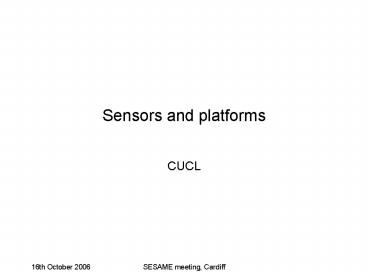Sensors and platforms - PowerPoint PPT Presentation
1 / 16
Title:
Sensors and platforms
Description:
System requirements for wireless sensor platform. 16th October 2006 ... based ... 320 Bytes (Calibrated inertial and magnetic data) Header = 40 Bytes ... – PowerPoint PPT presentation
Number of Views:83
Avg rating:3.0/5.0
Title: Sensors and platforms
1
Sensors and platforms
- CUCL
2
Overview
- CUCL experience
- Inertial and pressure sensors
- Wireless platforms
- Initiate discussion
- What further types of sensors are worthy of
evaluation - System requirements for wireless sensor platform
3
Inertial Measurement Unit (IMU)
- 3D gyroscopes, 3D accelerometers, digital compass
(magnetometer) - Measurements
- Linear acceleration (3D)
- Rate of turn (3D)
- Direction of sensor relative to the magnetic
north - Output (derived results)
- 3D orientation (e.g. Euler angles) more
accurate - 3D translation not accurate
- Key parameters
- Stride length (SL) and Stride frequency (SF)
- Acceleration curve over 100m
- Rotation and translation of body parts
- Approximate costs
- Full IMU Xsens MTX 1000
- Separate components around US 10 each but
mounting them is an issue
4
Inertial sensor
XSens MTX
5
Inertial sensor
- Running and stepping on tape markers (1m apart)
6
Force sensors
- Force Sensing Resistors (FSR)
- Decrease in resistance with an increase in the
force applied to the active surface. - Cost 50 for a development kit with 16 sensors
Active area
Tail
7
Sentient Sports Shoes
8
Wireless platform and sensors
- Wireless sensor node (Tmote)
- 250kbps 2.4GHz IEEE 802.15.4 (Zigbee)
- 8MHz MSP430 microcontroller
- Integrated 12-bit ADC
- Software development in TinyOS
- 3 force sensors 0.5" diameter (middle and front
part of foot) - 1 force sensor 1.5" square (heel)
- 1 inertial unit with 3D accelerometers, 3D
gyroscopes, magnetometers
9
Preliminary Experiments
- Jogging 50 meters
- Expected pattern of applied forces
- Heel Left side impact absorption
- Right side Toe generates impulse for the next
stride - Not yet interested in the magnitude of forces
- Real-time data gathering
Toe
Right
Left
Heel
10
Preliminary Results
Heel, left, right, toe
11
Bend Sensors / Optical-based
- ShapeTape - thin flexible ribbon which measures
the attitude of the tape at various positions
along its length. - Evaluation of the ShapeTape Tracker for Wearable,
Mobile Interaction - Yohan Baillot, Joshua J. Eliason, Greg S.
Schmidt, J. Edward Swan II, Dennis Brown, Simon
Julier, Mark A. Livingston, Lawrence Rosenblum,
Virtual Reality Laboratory, Naval Research
Laboratory, Washington D.C. - Conclusion ShapeTape is not appropriate for
interactions which require a high degree of
accuracy. However, ShapeTape is capable of
reproducing the qualitative motion the user is
performing and thus could be used to support 3D
interaction. - Cost range of 1000 - 2000
12
Bend sensor / Resistance-based
- Resistance proportional to the degree of flexing
and bending - Coated substrate, such as plastic, that changes
in electrical conductivity as it is bent - Cost 40
13
Distance Sensor/Proximity
- Sharp GP2D12
- Measure distance between itself and an object
that is within a distance range of 10cm (4") to
80cm (30") - Cost 15
14
Pulse Oximeter (SpO2)
- Indicates the percentage of hemoglobin molecules
in the arterial blood which are saturated with
oxygen. - Approach measures the amount of red and infrared
light received by the detector and calculates the
amount absorbed - Two options
- Dolphin clipper sensor (Imperial College)
- Smaller the BCI Medical Micro-Power Pulse
Oximeter, measuring 39 mm 20 mm with a current
draw of just 6.6 mA at 3 V. - They also measure heart rate
15
Other physiological sensors
- ECG
- EMG
- Breathing rate
16
Issues
- Size and wearability of sensor nodes
- System integration
- Drift over time - inertial sensing
- Body sensor network
- Realtime
- High sampling rate
- High volume of data
- Aggregation and compression on board
- Network of 5 inertial Xsens Mtx units
- Magnetometer gyroscope accelerometer
timestamp - 9 fields x 32B 32B 320 Bytes (Calibrated
inertial and magnetic data) - Header 40 Bytes
- ?Sampling Rate 100 samples/second
- Total throughput (320 40) x 100 x 5 nodes
1.44 Mbps - Throughput issue for wireless (ZigBee, Bluetooth,
etc)































